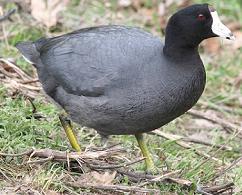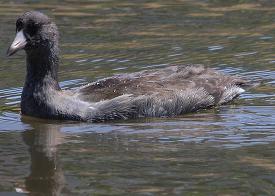American Coot 
Identification and Pictures
(Fulica americana)
American coots are a duck like bird with short
wings and a short tail, about 13 to 16 inches. They have a
slate gray body, white chicken like bill with dark red ring
near the tip, and black head and neck with a red-orange eye.
There is a dark shield on the top of the bill where it meets
the forehead. Under the tail is
a divided white patch. They have yellow legs and big lobbed feet. A
white border can be seen on wings when in flight.
They pump
their head and neck back and forth while swimming. When
they take off they run across the water with their wings
flapping to get air born.
The sexes are similar. Younger birds are
paler and chicks have a hairy orange-red head and shoulders.
Photos by Keith
Lee. The camera I use is the Canon
EOS 40D.


I guess this is where the
term "Crazy as a Coot" comes from.
This Coot would flap his wings to get the box
moving. He would then stand on one leg until it
stopped. I watched for some time as he kept repeating
this.
Coot sound
Sounds are Ka-ha ka-ha, short cackling sounds, and a
grating kuk-kuk-kuk-kuk.
Preferred Habitat
Summer range is across much of Canada, and
Northern U.S. They will migrate south in the winter but
are year round residents in much of the western, and southern
U.S. as long as they have access to open water.
They are found in ponds, marshes and lakes. In
winter they can be seen in costal bays, inlets and fields.
Breeding and Nesting
Mating season is around May or June, and both
sexes will do displays to attract the other. During
these displays they will splash around while calling to each
other. Coots usually nest on the edges of ponds.
Both birds build a nest of stems, and leaves on a floating
platform. It will be hidden in the vegetation,
and anchored to reeds. The female will lay 8 to 12 buff eggs with
brown spots.
Both birds will care for the eggs as well as the roles of feeding the
young, and teaching them to dive. The young may be
divided up, each parent taking responsibility for half of
them. The eggs hatch in
around 23 days. Shortly after hatching the young begin
to swim, and follow the parents to be fed. They will be
able to fly in 5 to 6 weeks.
Food
Coot's diet is mostly plant material but they also feed on
insects, worms, small fish, and tadpoles. They feed sometimes in
small flocks on the shore, on lawns, and on the water.
They will dive for food with upward jump before plunging
beneath the water. They will bring up plants from the
bottom then go through them to pick out anything edible.
To learn about other favorite
birds click here.

|
